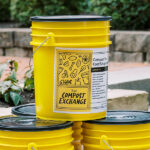
Sally Brown
BioCycle January 2015
Raining here in Seattle. Glad I gave the dog a long walk late this morning during a break in the precipitation. I may not fully have bought into living in Seattle during the rainy season, but I have fully bought into bioretention systems. Not everyone has however. More municipalities are adopting green infrastructure for storm water management as an alternative to grey systems, but how do you get widespread buy-in? How do you get the neighbors to put in rain gardens or to let the cities have their way with the periodic parking strip where a portion of the lawn space along the street (i.e., parking strip) is transformed into a bioswale to maximize water infiltration?
One way might be to express the impact that these systems have in a way that everyone can understand. Instead of talking about the ecosystem benefits of increased water infiltration into the soil and subsurface in comparison to overland flow and increased potential for combined sewer overflows, how about we express this in terms of how much water actually falls on the sidewalk and not into the ground?
That is something that you can actually figure out. A typical square of concrete is about 1 x 1 meters (m). Do your hopscotch as you go down the block and you’ll potentially count about 100 of those squares. So let’s see how much water that adds up to.
One way to start is with a one-inch (let’s cheat and call that 3 cm even though it is really 2.54) rain event. So for your single square of concrete that means you have 1 m x 1 m x 0.03 m (3 cm) of water. That multiplies out to 0.03 cubic meters (m3) of water. What does that mean? One cubic meter of water is 1,000 liters (the metric system is a wonderful thing) so if you make the conversion, that 3 cm of rain on that one square of concrete turns into 30 liters.
Let’s put this in symbols to help make the measurements meaningful. One symbol can be a shower. A nice hot shower with the pouring rain outside sounds lovely right now. A high-pressure shower uses about 70 liters of water (a water efficient shower uses about half that). So for that one block of concrete for the one rain event, you have the equivalent of about half of a great shower.
Let’s scale this to the block level. To do that you simply take the amount per square of concrete times the number of squares per block. Assuming your block is 100 m long: 30 liters per square x 100 squares per block = 3,000 liters.
Now you are talking showers, 43 showers — the good kind too. That means if 10 houses are on that block (just looked at Google Maps for my neighborhood in Seattle and 10 is about right), each house would rate 4.3 showers. Likely enough for one per person.
The next step is to see what that looks like when you consider a years’ worth of rain. Despite my current state of despair about rain in Seattle (November is the wettest and the darkest), we get the same amount of rain here that a lot of other cities do — about 30 inches (90 cm). Here again we can start with the single square of concrete:
1 m x 1 m x 0.9 m (90 cm of rain) = 0.9 m3 of water
1 m3 of water = 1,000 liters so 0.9 m3 of water = 900 liters
Visualize A Pool
Take that to the block level (and let me remind you that we are only considering one side of the block). Blocks have 4 sides so you can easily scale all of these calculations up to the whole block level:
900 liters per square per year x 100 squares per block = 900,000 liters of water.
I was thinking about a good way to visualize that and it just so happens that I had a really nice hot shower this evening after I went to swim practice. How about we express this one in terms of how many swimming pools we could fill? The pool I swam in is 25 meters long by about 18 meters across. For the purpose of this calculation, let’s make it about 1.5 meters deep. According to the pool volume calculator I found online, that pool holds about 550,000 liters of water.
In other words, the rainwater falling on just the sidewalk — not the parking strip, not the roof, not the garden, but just the sidewalk — of one block, and here again I am talking about one side of a square block, not the whole thing over the course of a year, is enough to fill almost two swimming pools.
So when you ask people in your community to install rain gardens and say that they can make a difference in how the water balance in your community will work, you have some numbers to show that you are being serious. It is so easy for people to claim that their part or their piece really doesn’t count. Just tell them these numbers and ask if they like to take showers. I bet they’ll catch on pretty quickly.
Sally Brown is a Research Associate Professor at the University of Washington in Seattle and a member of BioCycle’s Editorial Board.













